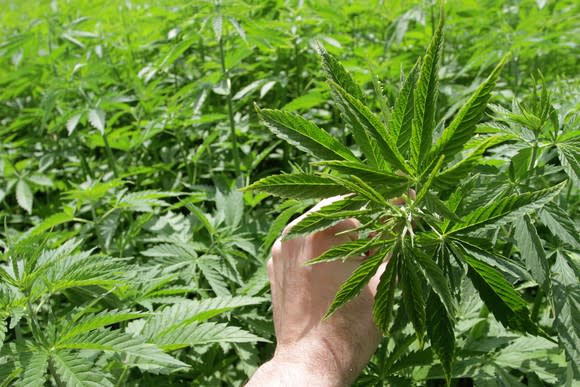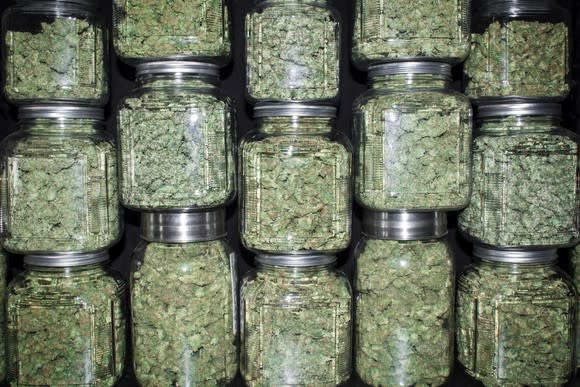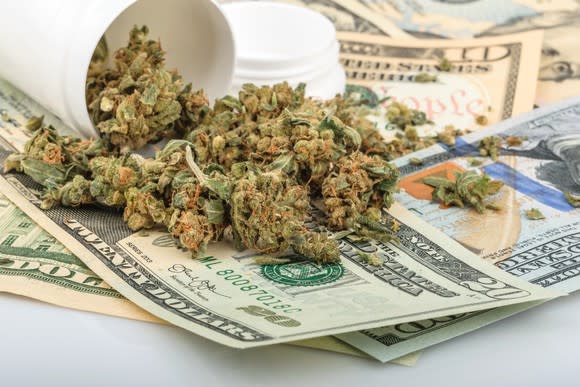7 Pot Stocks on Track to Deliver in Excess of 100,000 Kilograms of Cannabis a Year
We're now just one month away from perhaps the biggest day in the history of the marijuana industry. On June 7, Canada's Senate will vote on bill C-45, which is probably better known as the Cannabis Act. If approved in the Senate, which seems very likely, the bill could make its rounds through Canada's federal government shortly thereafter, ultimately resulting in recreational marijuana becoming legal for adults aged 18 and over.
According to an updated timeline from government officials, should the Cannabis Act be signed into law next month, sales of legal cannabis would be expected to commence in August or September. The delay of eight to 12 weeks between legalization and first sale is to allow dried cannabis to make its way from growers to retail dispensaries.

Image source: Getty Images.
These seven marijuana stocks control a lot of green
As a result of this expected legalization, cannabis growers have been spending at a frenzied pace in order to increase their production capacity. The Canadian market, by a number of estimates, is expected to demand around 800,000 kilograms of cannabis each year. Meanwhile, more than two dozen other foreign countries have legalized medicinal marijuana in some capacity, offering the possibility to export excess cannabis to these markets.
After months of dealmaking, partnerships, organic greenhouse projects, and some monster acquisitions, there have emerged seven pot stocks that are on pace to deliver more than 100,000 kilograms of cannabis a year when at full capacity.
1. Canopy Growth Corp.: Approximately 500,000 kilograms
The likely kingpin of the group in terms of annual production is Canopy Growth Corp. (NASDAQOTH: TWMJF). The company itself has been tightlipped about its actually annual production figure, as well as when its greenhouse facilities in British Columbia are expected to be completed. However, it did note recently that, with cultivation license approvals from Health Canada, its licensed grow space has tripled this year to 2.4 million square feet.
Ultimately, Canopy Growth is on track to have 5.7 million square feet of growing space, which I believe will allow for up to 500,000 kilograms of annual production. Combined with its superior distribution channel, which includes physical retail stores, online sales, and key partnerships, including minority stakeholder Constellation Brands, Canopy is a clear leader in this space.

Image source: Getty Images.
2. Aurora Cannabis: More than 430,000 kilograms
Not too far behind Canopy Growth is Aurora Cannabis (NASDAQOTH: ACBFF), which has grown every which way over the past year, and is on track to deliver more than 430,000 kilograms in fully funded capacity.
Aurora Cannabis has its organic greenhouse project known as Aurora Sky that'll span 800,000 square feet and produce more than 100,000 kilograms of dried cannabis a year. It also has a partnered project with Alfred Pedersen & Son in Denmark, known as Aurora Nordic, that's expected to deliver 120,000 kilograms a year. In March, Aurora closed the priciest pot acquisition in history: Saskatchewan-based CanniMed Therapeutics. And more recently, the company announced a deal to build a 1.2-million-square-foot facility in Medicine Hat, Alberta, which will produce 150,000 kilograms a year. In terms of expansion, few, if any, pot stocks have been more aggressive than Aurora Cannabis.
3. Aphria: 230,000 kilograms
The next-largest cannabis producer is Aphria (NASDAQOTH: APHQF), which is expected to deliver 230,000 kilograms of fully funded capacity, per company estimates. Aphria One is a four-phase, more than $100 million project that should yield 100,000 kilograms of annual production. Meanwhile, Aphria Diamond is a partnered project with Double Diamond Farms capable of yielding 120,000 kilograms a year. The remainder is expected to come from Aphria's acquisition of Broken Coast Cannabis.
Like Canopy, Aphria has an impressive distribution network in place that should help it move its cannabis. The company's acquisition of Nuuvera, the second-priciest marijuana deal on record, along with a handful of existing export deals, pushes the number of countries Aphria can market to (including Canada) up to 12.

Image source: Getty Images.
4. MedReleaf: 140,000 kilograms
Another producer that's risen the ranks in terms of annual yield is Ontario-based MedReleaf (NASDAQOTH: MEDFF). Prior to the beginning of 2018, MedReleaf was only on track to deliver about 35,000 kilograms of cannabis when at fully capacity. This included the company's existing Markham facility, as well as expansion of the Bradford facility, which offered more than four times as much growing space as Markham.
The real game changer for MedReleaf was its 164-acre land acquisition in Ontario, which was announced in late February. There's already an existing greenhouse facility on 69 acres of this property, known as the Exeter facility, which MedReleaf is going to retrofit to produce cannabis. Not having to build a greenhouse from the ground up saves both time and money. When complete, Exeter should yield 105,000 kilograms a year, pushing production at full capacity to 140,000 kilograms a year.
5. OrganiGram Holdings: 113,000 kilograms
One of the bigger surprises thus far in 2018 was the considerable increase in annual production offered by OrganiGram Holdings (NASDAQOTH: OGRMF). Having previously forecast 65,000 kilograms in peak annual yield, OrganiGram raised its forecast to 113,000 kilograms when at full capacity. Why the change? It primarily has to do with crop yield handily surpassing the company's model estimates.
Also interesting is the fact that OrganiGram, unlike its peers, maintains just a single grow site at Moncton, New Brunswick. Centralizing its growing in a single location is one of the ways it's been able to keep its costs down. When combined with its growing focus on cannabis oils, a significantly higher-margin product relative to dried cannabis, it's not hard to see why OrganiGram could very well be the only "marijuana value stock."

Image source: Getty Images.
6. Hydropothecary Corp.: 108,000 kilograms
An under-the-radar cannabis grower that's emerged from the shadows in a big way since December is Quebec-based Hydropothecary (NASDAQOTH: HYYDF). Already sporting its 65-acre Gatineau, Quebec facility, Hydropothecary announced the acquisition of 78 acres of land adjacent to its existing facility in December. This land will house a 1-million-square-foot greenhouse that's expected to increase the company's growing capacity to an aggregate of 1.3 million square feet, allowing for 108,000 kilograms of dried cannabis production a year, when at fully capacity.
Hydropothecary is certainly incentivized to step up its production, with the company securing the largest-ever supply deal in Canada: a five-year deal that'll see Hydropothecary supply Quebec with an aggregate of 200,000 kilograms. Though production for the fourth and fifth years is estimated at this point, Hydropothecary's management feels pretty confident in forecasting a double-digit percentage increase in demand.
7. Cannabis Wheaton Income Corp.: 230,000 kilograms
Last, but not least, is weed-based royalty and streaming company Cannabis Wheaton Income Corp. (NASDAQOTH: CBWTF). You might notice that while the aforementioned six pot stocks were presented in descending order of annual yield, Cannabis Wheaton hasn't been. That's because Cannabis Wheaton isn't a traditional grower. Instead, it acts as a middleman. It provides upfront capital to growers looking to expand capacity, and in return receives a percentage of their production at a well below-market rate. Cannabis Wheaton then turns around and sells this received product at market prices, pocketing the difference as profit.
According to company estimates, it's secured more than a dozen licensing deals, has an internal rate of return of at least 60% on these deals, and expects to receive (and therefore sell) 230,000 kilograms of production from its licensed partners per year.
Given the rapidly changing nature of this industry via partnerships and acquisitions, it's possible we see substantive changes to this list in the future. But for the time being, these are the major players that investors should be monitoring as we barrel toward Canadian recreational legalization.
More From The Motley Fool
Sean Williams has no position in any of the stocks mentioned. The Motley Fool has no position in any of the stocks mentioned. The Motley Fool has a disclosure policy.
